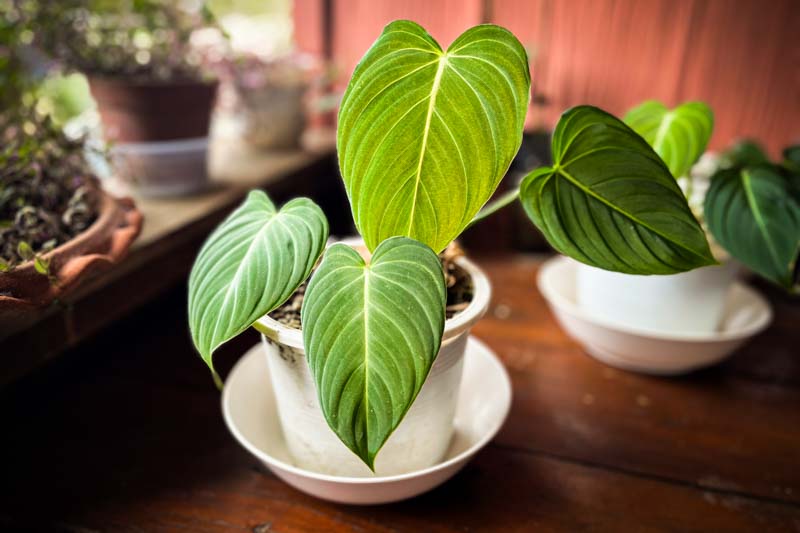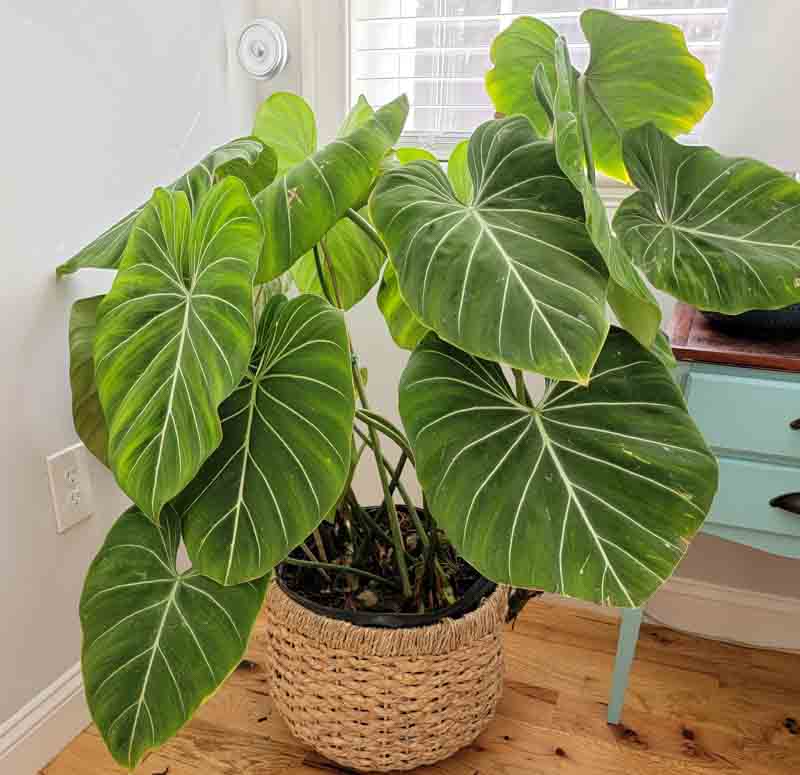Glorious Philodendron
Philodendron gloriosum stands out in the world of houseplants for its striking beauty, characterized by its large, velvety leaves and distinctive white veining.
Philodendron gloriosum is renowned for its stunning foliage, which can turn any indoor space into a lush, tropical oasis. The leaves are large, heart-shaped, and feature a deep green color with prominent white or cream-colored veins that contrast beautifully against the velvety surface of the leaves. The plant’s overall appearance exudes elegance and sophistication, making it a prized possession among plant enthusiasts.
Native: Philodendron gloriosum is native to the dense rainforests of Colombia, as well as parts of Central and South America. This terrestrial plant thrives in the humid, warm, and shaded understorey of these tropical forests, where it can grow on the forest floor. It belongs to the arum family (Araceae), along with Zantedeschia (Calla Lily), Caladium (Angel Wing), Monstera (Swiss Cheese Plant), or Colocasia (Elephant Ear).
Plant Type and Habit: Philodendron gloriosum is a crawling, evergreen perennial with new leaves emerging from the center of the plant and extending outward on the ground.
Size: In its natural habitat, Philodendron gloriosum can spread widely, with individual leaves reaching up to 3 feet in length (90 cm). When cultivated indoors, the plant typically grows to a more manageable size, reaching 2-3 feet in height (24-36 cm). Its growth rate is moderate, allowing enthusiasts to gradually witness the spectacular unfolding of each new leaf.
Flowers: Philodendron gloriosum can produce flowers, though it’s a rare sight in indoor environments. The flowers, typical of Philodendrons, consist of a spadix surrounded by a spathe. However, the main allure of this plant lies in its foliage rather than its flowers.
Foliage: The foliage of Philodendron gloriosum is its standout feature. Each leaf is a work of art, with a rich, velvety texture and striking veining that seems almost hand-painted. The leaves emerge rolled up and gradually unfurl to reveal their full glory, a process that is a delight to observe.
Hardiness: If planted outdoors, this plant is hardy in USDA zones 10-12. It is best suited to indoor environments where temperatures can be kept consistent, ideally between 65-85°F (18-29°C). It is not frost-tolerant and should be protected from cold drafts.
Uses: Philodendron gloriosum is primarily used for ornamental purposes. Its majestic presence makes it a perfect focal point in any indoor garden, living room, or office space.
Toxicity: Philodendrons are toxic to humans, cats, and dogs if ingested. They contain calcium oxalate crystals that can cause mouth and stomach irritation. Contact with the sap may cause skin irritation.
Deer and Rabbits: Its toxicity generally deters deer and rabbits.
Benefits: Beyond its aesthetic value, it can also help purify the air, making indoor environments healthier and more pleasant. The plant’s ease of care and ability to adapt to various indoor conditions make it suitable for both novice and experienced plant keepers.

Light: Philodendron gloriosum prefers bright, indirect light to maintain its unique coloring. Avoid direct sunlight, which can scorch their leaves.
Soil: Use a well-draining, peat-based potting mix. Philodendron gloriosum prefers slightly acidic to neutral pH levels. Ensure the pot has drainage holes to prevent water from accumulating at the bottom.
Water: Water your Philodendron gloriosum when the top inch of soil feels dry to the touch. Over-watering can lead to root rot, so ensure proper drainage.
Temperature and Humidity: Ideal temperatures range between 65°F and 85°F (18°C to 29°C). Philodendrons can tolerate a wider range, but sudden temperature drops or exposure to cold drafts should be avoided. These tropical plants enjoy high humidity, between 50-60%, but can adapt to average household humidity levels. For added humidity, mist the leaves regularly, place a humidifier nearby, or set the plant on a pebble tray filled with water.
Fertilization: Feed your Philodendron gloriouum with a balanced, water-soluble fertilizer every 4-6 weeks during the growing season (spring and summer). Reduce feeding in fall and winter when growth slows.
Pruning: Pruning is not strictly necessary but can help maintain shape and encourage fuller growth. Use sterile scissors or pruning shears to trim away any yellow or damaged leaves and to manage size.
Repotting: Repot every 2-3 years or when roots start to crowd the pot. Choose a pot that is one size larger than the current one to ensure continued growth.
Propagating Philodendron plants is a straightforward and rewarding process, allowing you to expand your collection or share with friends and family. The most common method is stem cuttings, which can be rooted in water or soil. Here’s how to do it:
Choose a Healthy Stem: Look for a healthy stem with at least 2-3 leaves and a few nodes (the points on the stem where leaves attach and roots tend to grow).
Make the Cut: Using a clean, sharp knife or scissors, cut just below a node. The cutting should be about 4-6 inches long.
Prepare the Cutting: Remove any leaves that would be submerged when you place the stem in water to prevent rot.
Root in Water: Place the cutting in a glass or jar of water, ensuring the node is submerged. Leave the leaves out of the water. Place the jar in a warm, bright spot with indirect light.
Change the Water Regularly: Refresh the water every few days to keep it clean, which helps prevent bacterial growth.
Wait for Roots: Roots should start to emerge from the nodes in about 2-4 weeks. Wait until the roots are a few inches long before potting.
Potting: Once the roots are sufficiently developed, plant the cutting in a pot with well-draining soil. Care for it as you would a mature Philodendron.
Prepare Your Cutting: Follow the same steps as above to select and cut a healthy stem section.
Rooting Hormone (Optional): Dip the cut end of the stem in rooting hormone powder to encourage root growth. This step is optional but can enhance rooting success.
Plant the Cutting: Fill a pot with a well-draining potting mix. Make a hole in the center and insert the cut end of the stem, ensuring at least one node is buried beneath the soil surface.
Water and Cover: Water the soil lightly to settle it around the cutting. To create a humid microenvironment, you can cover the pot with a plastic bag or place it in a propagator. Ensure the leaves are not touching the plastic to prevent rot.
Care for Your Cutting: Place the pot in a warm, bright location with indirect light. Keep the soil consistently moist but not waterlogged.
Wait for Growth: In a few weeks, the cutting should start to root. You can gently tug on the plant after about 4 weeks; if there’s resistance, roots have formed.

Philodendrons can encounter pests, diseases, and other common problems, especially when grown indoors.
Spider Mites: These tiny pests can be identified by the fine webs they weave on the plant. They cause yellowing or speckled leaves. Increase humidity around the plant and wash it with a strong stream of water. For severe infestations, use insecticidal soap or neem oil.
Mealybugs: These white, cottony pests tend to cluster in leaf axils and under leaves, sucking sap and weakening the plant. Remove with alcohol-dipped cotton swabs or apply neem oil.
Aphids: Small, soft-bodied insects that can be green, black, brown, or pink, aphids typically feed in groups on the undersides of leaves. Combat them with a gentle spray of water, neem oil, or insecticidal soap to protect the plant’s health and appearance.
Scale insects: Hard or soft-bodied insects that attach themselves to the stems or leaves, causing yellowing and growth stunting. Scrape off with a fingernail or use a cotton swab dipped in rubbing alcohol. Insecticidal soap or neem oil may also be used.
Root rot: Overwatering is the primary cause, leading to brown, mushy roots and yellowing leaves. Reduce watering, improve drainage, and repot the plant into fresh, well-draining soil. Severely affected roots should be trimmed before repotting.
Leaf spot: Fungal or bacterial infections can cause dark or black spots on leaves, often with a yellow halo. Increase air circulation, avoid wetting leaves when watering, and remove affected leaves. Fungicides or bactericides may be necessary in severe cases.
Yellowing Leaves: Overwatering, poor drainage, or nutrient deficiencies can cause leaves to turn yellow. Adjust watering habits, ensure the pot has adequate drainage, and consider applying a balanced, water-soluble fertilizer.
Leggy Growth or Small Leaves: Insufficient light can lead to stretched stems and smaller than normal leaves. Move the plant to a location with more indirect light.
Loss of Variegation: If variegated Philodendrons revert to solid green, it’s often due to insufficient light. Increase light exposure, but avoid direct sunlight to encourage variegation.
Brown Leaf Tips: Often a sign of low humidity or salt buildup from tap water. Increase humidity around the plant and consider using filtered water or rainwater.
| Hardiness |
10 - 12 |
|---|---|
| Plant Type | Houseplants, Perennials |
| Plant Family | Araceae |
| Genus | Philodendron |
| Exposure | Partial Sun |
| Season of Interest |
Spring (Early, Mid, Late) Summer (Early, Mid, Late) Fall Winter |
| Height |
2' - 3' (60cm - 90cm) |
| Maintenance | Low |
| Water Needs | Average |
| Soil Type | Loam |
| Soil pH | Acid, Neutral, Alkaline |
| Soil Drainage | Moist but Well-Drained |
| Characteristics | Showy, Evergreen |
| Tolerance | Deer, Rabbit |
| Garden Uses | Patio And Containers |
| Hardiness |
10 - 12 |
|---|---|
| Plant Type | Houseplants, Perennials |
| Plant Family | Araceae |
| Genus | Philodendron |
| Exposure | Partial Sun |
| Season of Interest |
Spring (Early, Mid, Late) Summer (Early, Mid, Late) Fall Winter |
| Height |
2' - 3' (60cm - 90cm) |
| Maintenance | Low |
| Water Needs | Average |
| Soil Type | Loam |
| Soil pH | Acid, Neutral, Alkaline |
| Soil Drainage | Moist but Well-Drained |
| Characteristics | Showy, Evergreen |
| Tolerance | Deer, Rabbit |
| Garden Uses | Patio And Containers |
How many Philodendron gloriosum (Glorious Philodendron) do I need for my garden?
| Plant | Quantity | |
|---|---|---|
| Philodendron gloriosum (Glorious Philodendron) | N/A | Buy Plants |
Create a membership account to save your garden designs and to view them on any device.
Becoming a contributing member of Gardenia is easy and can be done in just a few minutes. If you provide us with your name, email address and the payment of a modest $25 annual membership fee, you will become a full member, enabling you to design and save up to 25 of your garden design ideas.
Join now and start creating your dream garden!
Create a membership account to save your garden designs and to view them on any device.
Becoming a contributing member of Gardenia is easy and can be done in just a few minutes. If you provide us with your name, email address and the payment of a modest $25 annual membership fee, you will become a full member, enabling you to design and save up to 25 of your garden design ideas.
Join now and start creating your dream garden!